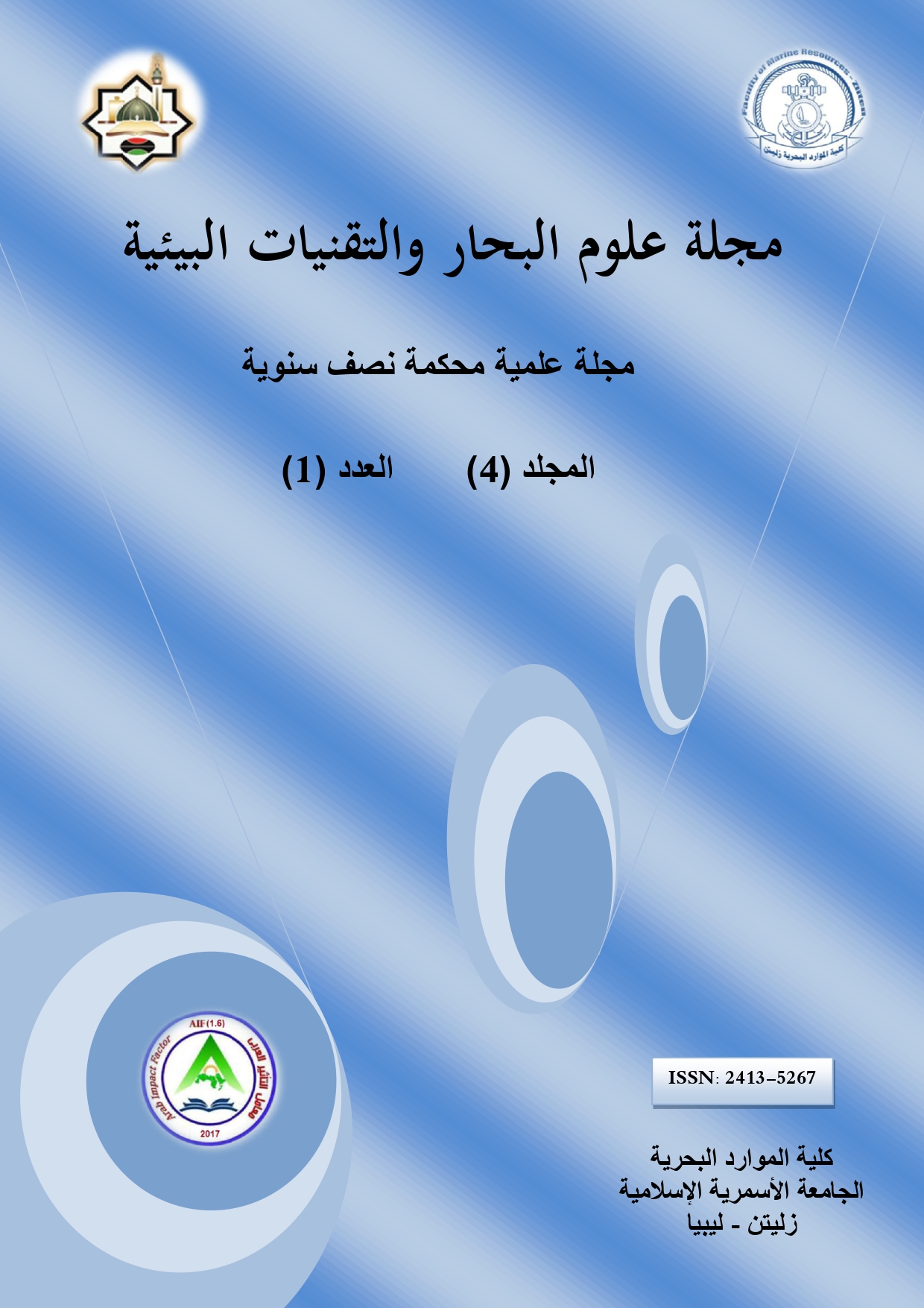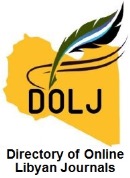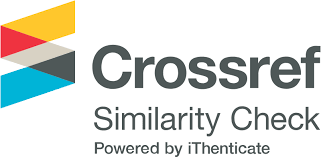دراسة النمو الحضري بمنطقة الخمس باستخدام نظم المعلومات الجغرافية والاستشعار عن بُعد
DOI:
https://doi.org/10.59743/jmset.v4i1.82الكلمات المفتاحية:
نظم المعلومات الجغرافية، الاستشعار عن بعد، التطور العمراني، استعمال الاراضي، التأثير البيئيالملخص
التوسع العمراني الضار أصبح مشكلة خطيرة على استعمالات الاراضي في ليبيا. في هذه الدراسة قمنا باستعمال تقنية نظم المعلومات الجغرافية والاستشعار عن بعد لقياس التغير العمراني بمنطقة الخمس الساحلية. أظهرت النتائج المتحصل عليها من هذه الدراسة زيادة التطور العمراني بنسبة تزيد عن 658% خلال الاربعين سنة الماضية (1976-2016). كما أن قطاع الزراعة هو أحد القطاعات التي تضررت بقوة بسبب هذا النمو الاسي العمراني مؤدياً الى فقدان الاراضي المنتجة للفواكه والخضراوات. بالإضافة إلى فقدان المصادر الرئيسية للغذاء فإن التطور العمراني أحدث أثاراً بيئية مهمة في هذه المنطقة الساحلية. هذه الدراسة توضح أيضاً أهمية وحساسية التقنيات المكانية في تقييم ومراقبة التغيرات البيئية الإقليمية.
التنزيلات
المراجع
Al-shalabi M., Billa L., Pradhan B., Mansor S., and Al-Sharif A.A.A. (2013a). Modelling urban growth evolution and land use changes using GIS based cellular automata and SLEUTH models: the case of Sana’a metropolitan city, Yemen. Environmental Earth Sciences, 70(1): 425–437.
Al-shalabi M., Pradhan B., Billa L., Mansor S., and Althuwaynee O. F. (2013b). Manifestation of remote sensing data in modeling urban sprawl using the SLEUTH model and brute force calibration: a case study of Sana’a City, Yemen. Journal of the Indian Society of Remote Sensing, 41(2): 405–416.
Alsharif A, and Pradhan B. (2014). Urban Sprawl Analysis of Tripoli Metropolitan City (Libya) Using Remote Sensing Data and Multivariate Logistic Regression Model. J Indian Soc Remote Sens, 42(1):149–163.
Angotti T. (1993). Metropolis 2000: Planning, poverty and politics. Routledge, London.
Cheng J., Ottens H., Masser I., and Turkstra J. (2003). Understanding urban growth: a conceptual model. International Journal of Urban Sciences, 7: 83–101.
Epstein J., Payne K., and Kramer E. (2002). Techniques for mapping suburban sprawl. Photogr. Eng. Remote Sens., 63 (9): 913–918.
Firman T. (1997). Land conversion and urban development in the northern region of West Java, Indonesia. Urban Studies, 34: 1027–1046.
Gillham O. (2002). The limitless city: A primer on the urban sprawl debate, pp.: 328, Island Press, Washington, DC, USA.
Green K., Kempka D., and Lackey L., 1994. Using remote sensing to detect and monitor land-cover and land-use change. Photogr. Eng. Remote Sens., 60: 331–337.
Greenberg J.D., and Bradley G.A. (1997). Analyzing the urban–wildland interface with GIS. J. Forestry, 95:18–22.
Gomarasca M.A., Brivio P.A., Pagnoni F., Galli A. (1993). One century of land use changes in the metropolitan area of Milan (Italy). Int. J. Remote Sens., 4 (2): 211–223.
Haack B.N., and Rafter A. (2006). Urban growth analysis and modelling in the Kathmandu valley, Nepal. Habitat International, 30(4): 1056–1065.
Helbich M., and Leitner M. (2010). Postsuburban spatial evolution of Vienna's urban fringe: evidence from point process modeling. Urban Geography, 31: 1100–1117.
Huang B., Zhang L., and Wu B. (2009). Spatiotemporal analysis of rural–urban and conversion. International Journal of Geographical Information Science, 23: 379–398.
Irwin E.G., and Geoghegan J. (2001). Theory, data, methods: developing spatially explicit economic models of land use change. Agriculture, Ecosystems & Environment, 85: 7–24.
Jat M.K., Garg P.K., and Khare D. (2008). Monitoring and modelling of urban sprawl using remote sensing and GIS techniques. International Journal of Applied Earth Observation and Geoinformation, 10: 26–43.
Jiang B., and Yao X. (2010). Geospatial analysis and modelling of urban structure and dynamics, Vol. 99, Springer Science & Business Media.
Jokar Arsanjani, J. (2011). Dynamic land use/cover change modelling: Geosimulation and multiagent-based modeling, series: springer theses, XVII, pp.: 139, Springer: Berlin Heidelberg.
Kumar M.J, Garg P.K., and Khare D. (2008). Monitoring and modelling of urban sprawl using remote sensing and GIS techniques. International Journal of Applied Earth Observation and Geoinformation, 10(1): 26–43.
Lambin E.F., Turner B.L., Geist H.J., Agbola S.B., Angelsen A., Bruce, J. W., ….and et al. (2001). The causes of land-use and land-cover change: moving beyond the myths. Global Environmental Change, 11: 261–269.
López E., Bocco G., Mendoza M., and Duhau E. (2001). Predicting land-cover and land-use change in the urban fringe: a case in Morelia city, Mexico. Landscape and Urban Planning, 55: 271–285.
Lu D., and Weng Q. (2005). Urban classification using full spectral information of Landsat ETM+ imagery in Marion County, Indiana. Photogr. Eng. Remote Sens., 71 (11): 1275–1284.
Mckinney M.L. (2002). Urbanization, Biodiversity, and Conservation: The impacts of urbanization on native species are poorly studied, but educating a highly urbanized human population about these impacts can greatly improve species conservation in all ecosystems. BioScience, 52(10): 883–890
Mundia C.N., and Aniya M. (2005). Analysis of land use/cover changes and urban expansion of Nairobi city using remote sensing and GIS. Int. J. Remote Sens., 26 (13): 2831–2849.
Stuckens J., Coppin P.R., and Bauer M.E. (2000). Integrating contextual information with per-pixel classification for improved land cover classification. Remote Sens. Environ.. 71: 282–296.
Stefanov W.L., Ramsey M.S., and Christensen (2001). Monitoring urban land cover change: an expert system approach to land cover classification of semiarid to arid urban centers. Remote Sens. Environ., 77: 173–185.
Sudhira H.S., Ramachandra T.V., and Jagadish K.S. (2004). Urban sprawl: metrics, dynamics and modelling using GIS. International Journal of Applied Earth Observation and Geoinformation, 5: 29–39.
Sugumaran R., Pavuluri M.K., and Zerr D. (2003). The use of high resolution imagery for identification of urban climax forest species using traditional and rule based classification approach. IEEE Trans. On Geosci. Remote Sens., 41 (9): 1933–1939.
Tv R., Aithal B.H., and Sanna, D.D. (2012). Insights to urban dynamics through landscape spatial pattern analysis. International Journal of Applied Earth Observation and Geoinformation, 18: 329–343.
Veldkamp A., and Lambin E. F. (2001). Predicting land-use change. Agriculture, Ecosystems & Environment, 85: 1–6.
Verburg P.H., Kok K., Pontius R.G., and Veldkamp A. (2006). Modeling land-use and land-cover change. In Land-use and land-cover change, pp.: 117-135, Springer, Berlin, Heidelberg.
Verburg P., and Overmars K. (2007). Dynamic simulation of land-use change trajectories with the clues model. In Modelling land-use change, pp.: 321-337, Springer, Dordrecht.
Vogelmann J.E., Sohl T., and Howard S.M. (1998). Regional characterizations of land cover using multiple sources of data. Photogr. Eng. Remote Sens., 64: 45–57.
Yang X., and Liu Z. (2005). Use of satellite derived landscape imperviousness index to characterize urban spatial growth. Comput. Environ. Urban Syst., 29: 524–540.
Yang X., and Lo C.P. (2003). Modelling urban growth and landscape changes in the Atlanta metropolitan area. Int. J. Geogr. Inform. Sci., 17(5): 463–488.
Yeh A.G.O., and Li X. (2001). Measurement and monitoring of urban sprawl in a rapidly growing region using entropy. Photogr. Eng. Remote Sens., 67 (1): 83-90.
Youssef A.M., Pradhan B., and Tarabees E. (2011). Integrated evaluation of urban development suitability based on remote sensing and GIS techniques: contribution from the analytic hierarchy. Arabian Journal of Geosciences, 4(3–4): 463-473.
Zhang J., Li P., and Wang J. (2014). Urban built-up area extraction from Landsat TM/ETM+ images using spectral information and multivariate texture. Remote Sens., 6: 7339–7359.
Zhao Y., and Murayama Y. (2011). Urban dynamics analysis using spatial metrics geosimulation. In Spatial analysis and modeling in geographical transformation process, pp.: 153-167, Springer, Dordrecht.
التنزيلات
منشور
إصدار
القسم
الرخصة
الحقوق الفكرية (c) 2018 مجلة علوم البحار والتقنيات البيئية

هذا العمل مرخص بموجب Creative Commons Attribution 4.0 International License.












